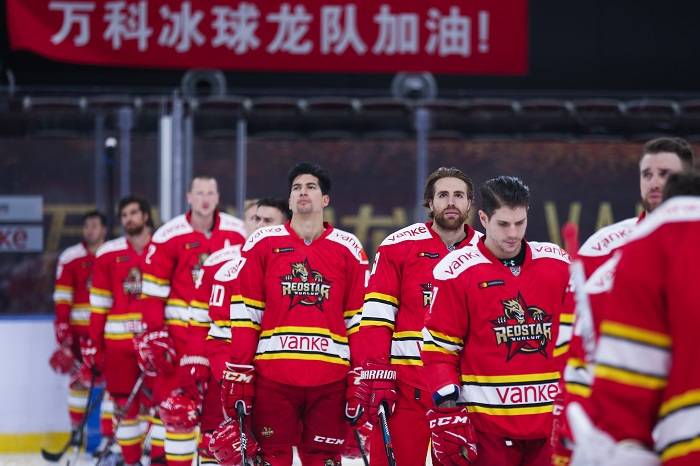The big homecoming
11 October 2019

It’s been a week of celebrations for Kunlun Red Star as the Dragons made their long-awaited return to Beijing. The Chinese capital has always been the team’s home, but in recent seasons much of the action has been moved to Shanghai or, more recently, Shenzhen.
On October 9, though, Red Star moved back to the new, purpose-built Shougang Arena and marked the occasion with a 2-1 home victory over Neftekhimik Nizhnekamsk. The following day the teams met again and produced the same scoreline in the Dragons’ favor, albeit after overtime in the second encounter. As homecomings go, it’s been pretty special for all concerned.
So, what’s the story about Shougang? Well, it opened early this year and staged the final two games of Kunlun’s regular season back in February. At once, it was a hit. A compact arena with a capacity of 3,000, it fills up quickly and generates a memorable gameday atmosphere. Picking up results also helps: in four games here, Red Star has won three and went to a shoot-out in another.
Attendances are also encouraging. The arena seats 3,000 spectators; 2,500 saw Wednesday’s game against Neftekhimik, there were slightly more for the return meeting on Thursday and last season’s match-ups attracted near-capacity crowds. Sunday’s game at home to Lokomotiv could see us close to another sell-out, given the attractive opposition and the convenience of getting to weekend.
Away from the KHL, the Women’s World Championship Division IB games played there in April also drew impressive attendances: China averaged almost 1,600 fans at its games, the overall tournament average was 1,199. By contrast, the Division IA championship played in Budapest at the same time had an average of 502 per game and the lowest crowd was just 38. The evidence is clear: hockey is finding a growing audience here in China.
And there’s a bigger picture. Once, the Shougang complex was a gritty industrial district. Steel mills dominated the smoky skyline, blast furnaces lit up the surroundings. The factories were moved out of town and now, 100 years after Shougang was founded, the Beijing site is enjoying a renaissance as the hub of China’s fast-growing winter sports program. Red Star’s rink, in a converted coal plant, is one of four in the complex. Together, they are at the apex of the country’s efforts to develop ice sports ahead of the 2022 Winter Olympics.
In hockey, where China will compete in the men’s Olympic championship for the first time, things have moved fast since 2015 and the announcement that Beijing would host the big event. At the top end, Kunlun Red Star has brought top level hockey to China, giving local audiences the chance to see some of the world’s best players at first hand. Competing in the KHL with a team that features Olympic medallists from 2018 has raised the profile of our game far beyond the level of the Asia League, where Chinese teams competed against the best from Japan and Korea.
The Red Star organization also offers a pathway for Chinese talent to progress. While it’s true that the KHL roster is dominated by players born outside of China – albeit increasingly players with Chinese heritage interested in reconnecting with their ancestral homeland – the club has been instrumental in developing Chinese teams to play in the second-tier VHL. This is more of a development league, an ideal proving ground for prospects to show that they, too, are worthy of a chance to compete with the best. After helping to establish the ORG team, which now operates independently of our club, Red Star has a new team in that league this season playing out of the Beijing Sports University.
Closer to the grass roots, it’s a similar success story. Since 2015, more than 5,000 youngsters have taken up hockey. These kids won’t be a part of the Chinese teams playing 2022 – they will still be too young for that – but they represent a new generation actively taking up ice hockey in our country. With more and more youngsters playing the game, more and more parents seeing how much it can offer, and more and more opportunities for the talented to progress to the highest level, the future of Chinese hockey looks brighter than ever.















Leave a Reply